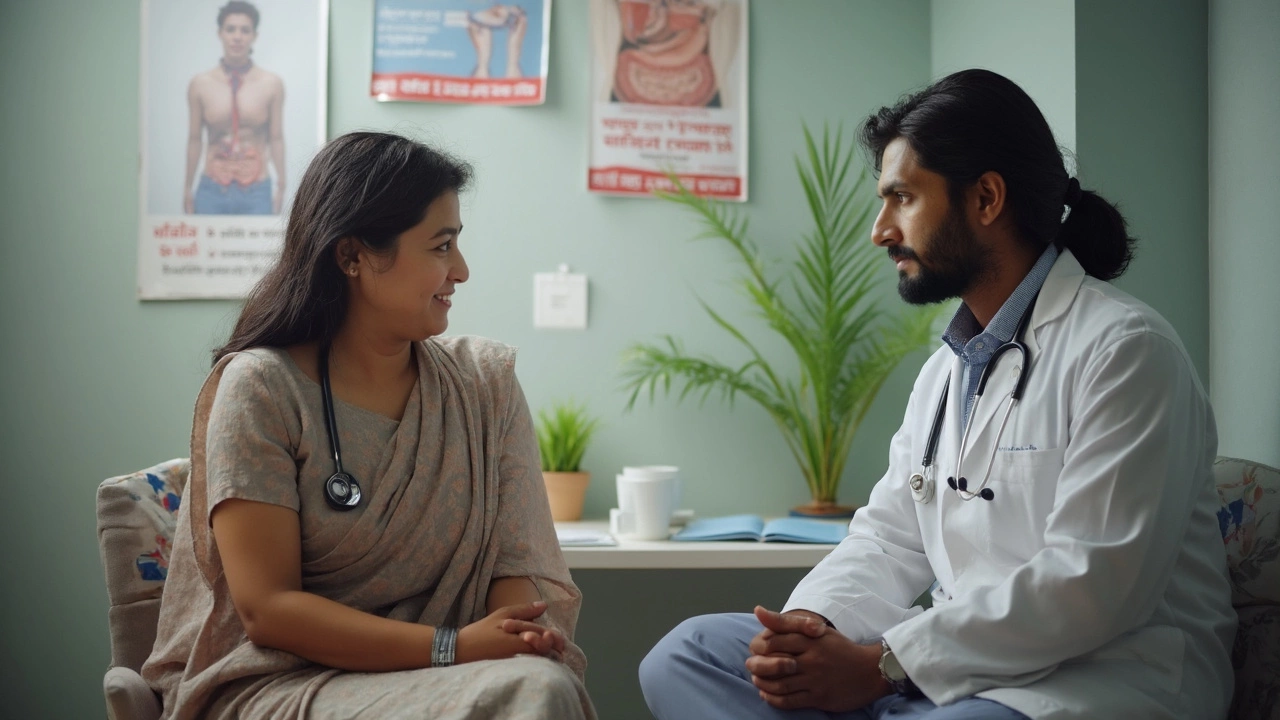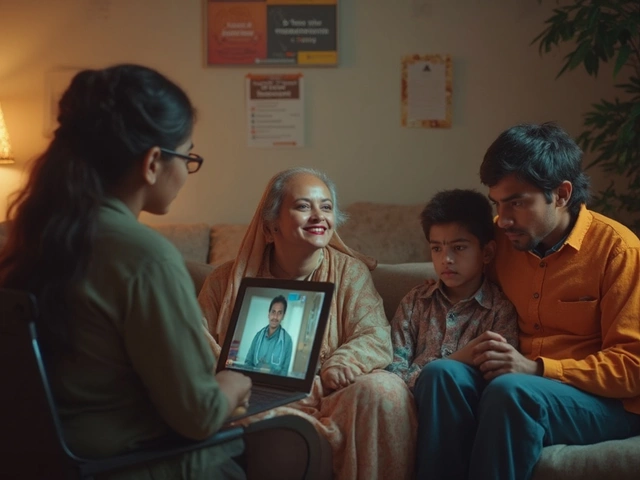Some cancers creep in quietly and settle in deep before making themselves noticed. That’s why oncologists give them the chilling nickname: silent killers. The trouble? If you wait for strong, obvious symptoms, it might already be too late for the easiest treatments.
Ovarian and pancreatic cancers are the big names here. Both can grow for months, sometimes even years, with barely any warning signs. You could go about your daily business and not even realize your body is fighting a hidden battle. Regular aches and tiredness can be brushed off as a busy week or lousy sleep, but sometimes they’re masking something bigger.
If you’ve got a family history or just want to play it safe, regular check-ups, even basic blood tests, can tip you off earlier than you think. And the more you know about which symptoms actually matter—like unusual weight loss or new gut issues—the better you can advocate for yourself. Don't just wait around for the classic scary symptoms. Listening to subtle changes really could save your life.
- Not All Cancers Shout: What Makes a Cancer 'Silent Killer'?
- Meet the Top Silent Killers: Ovarian and Pancreatic Cancer
- Why Symptoms Stay Hidden So Long
- Small Warnings: Red Flags to Watch Out For
- Who Tops the Risk List?
- Getting Ahead: Tips for Early Detection and Talking to Your Doctor
Not All Cancers Shout: What Makes a Cancer 'Silent Killer'?
Most people expect cancer to come with clear red flags—lumps, blood, or intense pain. That’s not true for all types. Silent killer cancer is the label stuck to those that don’t show up with big warning signs until they’re much further along. When doctors talk about a cancer being silent, they’re not exaggerating. It just sits there, working quietly, while you feel more or less fine.
So, what makes a cancer 'silent'? These diseases tend to start in places where there’s a lot of room to grow, like the ovaries or pancreas. Your body doesn’t always have nerves in those areas that tell your brain, 'Hey, something’s wrong.' Even as cancer grows, you might just feel kind of tired or have a little stomach discomfort—symptoms that are easy to brush off. That’s why regular check-ups matter, especially if you’re at risk.
- Ovarian cancer often doesn’t cause symptoms until it spreads outside the ovaries.
- Pancreatic cancer can block important ducts slowly, making symptoms pop up only when it’s advanced.
- Both can be mistaken for harmless digestive or menstrual issues at first.
One UK study found that more than half of patients with pancreatic cancer had advanced-stage disease at diagnosis because the common symptoms—things like back pain or loss of appetite—don’t seem urgent at first. The same goes for ovarian cancer—70% of women don’t get diagnosed until it’s already spread.
| Cancer | % Diagnosed Late Stage |
|---|---|
| Ovarian | 70% |
| Pancreatic | 54% |
If you think about it, being called a silent killer cancer just means it’s extra sneaky. By the time it shows its face, the cancer might already have a head start on you. That’s why understanding what makes these cancers so quiet is the first step to catching them a little earlier.
Meet the Top Silent Killers: Ovarian and Pancreatic Cancer
When folks talk about the real silent killer cancers, ovarian cancer and pancreatic cancer top the list. Both get their reputation because they usually don't set off loud alarms in your body until they’ve already done a lot of damage. People often mistake their early symptoms for minor stuff—like stomach trouble or fatigue—so these cancers can fly under the radar for months or even years.
Ovarian cancer is especially sneaky. It's the fifth leading cause of cancer deaths among women, and if it's caught early, there’s a 90% five-year survival rate. But here’s the kicker—about 70% of cases are only found at stage III or IV when the odds drop fast. There aren't routine screening tests for this cancer, so knowing your risk and paying attention to symptoms matters.
Pancreatic cancer is just as stubborn. Survival rates are still pretty low—less than 11% of patients live five years past diagnosis. The pancreas is stuck low in your belly, so when cancer starts growing, there's plenty of space for it to spread out before you notice anything odd. Early signs can feel like vague back pain, loss of appetite, or weight loss you don’t try for. Most people notice something is wrong only when the cancer blocks digestive tracts or causes jaundice (yellowing skin or eyes).
| Cancer | Annual New Cases | 5-Year Survival Rate | Common Diagnosis Stage |
|---|---|---|---|
| Ovarian | ~19,700 | 50% | Late (Stage III/IV) |
| Pancreatic | ~66,400 | 11% | Late (Stage III/IV) |
Here’s what you should look out for:
- Bloating, belly pain, or feelings of fullness (ovarian cancer)
- Changes in bathroom habits, especially new constipation or diarrhea
- Mystery weight loss
- Back pain or mid-belly pain especially after eating (pancreatic cancer)
- Loss of appetite
- New jaundice (yellow skin or eyes)
If you notice these symptoms and they don’t go away in a few weeks, they’re worth mentioning to your doctor. Don’t brush them off as just getting older or a change in routine.
Why Symptoms Stay Hidden So Long
The real trouble with silent killer cancer types like ovarian and pancreatic cancer is that they blend in incredibly well. These cancers often develop deep inside the body, far from anything obvious or easy to check. While some cancers cause lumps or skin changes, the "silent" ones keep all their drama on the inside, which makes it easy to miss for both patients and doctors—at least in the early stages.
For example, early pancreatic cancer usually doesn't mess with your day-to-day at all. Most folks just feel fine, or maybe a little bloated or tired, which gets blamed on stress or a skipped meal. Ovarian cancer also tends to stick to mild signs like occasional stomach pain or feeling full quickly, which is easy to ignore.
The pancreas and ovaries just don't have tons of nerve endings giving off pain signals. Plus, there’s plenty of room for these cancers to grow before they press on other organs and finally make you feel awful. By that time, they may have already spread. Dr. Elizabeth Allen, a cancer researcher, points out:
"These tumors are good at hiding because the organs they're in aren’t very talkative when something's wrong. You usually don’t get hard-core symptoms until the cancer is advanced."
It gets trickier because there is no routine blood test or screening that works for everyone—especially for ovarian cancer. Mammograms catch breast cancer. Colonoscopies find colon cancer. But for silent killers, screening is hardly ever routine unless you know you’re high risk.
Check out this data on common 'hidden' cancers and when folks usually find out:
| Cancer Type | % Diagnosed at Late Stage | Common Screening? |
|---|---|---|
| Ovarian | ~70% | No |
| Pancreatic | ~80% | No |
| Breast | ~20% | Yes |
So, if you want a fighting chance with a silent killer, you’ve got to be proactive and keep an eye out for any small, nagging change that just doesn’t go away. It’s rarely about one big, obvious symptom—it’s about those little things that don’t make sense and stick around.

Small Warnings: Red Flags to Watch Out For
One of the biggest problems with silent killer cancer, especially ovarian cancer and pancreatic cancer, is that the symptoms are super subtle at first. These early warning signs don’t always seem serious, so it’s easy to brush them off. But paying attention gives you a shot at catching problems sooner.
- Unexplained weight loss – Dropping pounds without trying is often one of the earliest clues. If your jeans suddenly get loose and you’re eating like normal, don’t ignore it.
- Bloating or belly pain – For ovarian cancer, regular bloating or ongoing lower stomach pain can be a red flag, especially if it sticks around for more than a few weeks.
- Loss of appetite or feeling full quickly – Sudden changes in your appetite, or getting full after just a few bites, show up a lot in people with hidden cancers.
- New or growing jaundice (yellow skin or eyes) – With pancreatic cancer, yellowing skin or eyes can pop up way before severe pain hits. If you notice this, get it checked right away.
- Digestive changes – Weird changes in your poop, like pale stools, oily texture, or diarrhea, matter—especially with ongoing discomfort.
- Back pain – A dull, ongoing ache in your back, with no obvious reason, can be a sneaky sign of cancers growing deep inside.
Here's a snapshot of how common these early signs show up for people diagnosed with pancreatic or ovarian cancer:
| Symptom | % Pancreatic Cancer Patients | % Ovarian Cancer Patients |
|---|---|---|
| Unexplained weight loss | 60% | 35% |
| Bloating | 20% | 70% |
| Jaundice | 45% | 1% |
| Loss of appetite | 50% | 40% |
| Back pain | 35% | 25% |
Most folks wait too long to talk to their doctor because these symptoms seem harmless—they just hope it’ll go away. If you’ve got a gut feeling that something isn’t right, or if several small things add up, don’t wait. If you spot a cluster of these signs, especially if you’ve got a family history, push for a closer look. Early moves matter way more than you think when it comes to these silent killer cancers.
Who Tops the Risk List?
Not everyone faces the same shot at getting a silent killer cancer like ovarian or pancreatic cancer. The risk goes up for certain people—and knowing where you stand can actually help you do something about it.
Let’s break it down:
- Age: Most silent cancers, like pancreatic cancer or ovarian cancer, hit folks over 50. The odds go up as you get older.
- Family history: If a parent, sibling, or child had these cancers, your risk jumps. Genes play a big part, especially with mutations like BRCA1 or BRCA2 (well known for breast cancer but they crank up ovarian cancer risk, too).
- Lifestyle: Smoking is a huge one for pancreatic cancer. Drinking a lot, eating a high-fat diet, or not moving much can also nudge your risk higher.
- Chronic health issues: Diabetes and long-term pancreatitis aren’t just annoying—they’re red flags for pancreatic issues. Women with endometriosis or who’ve never been pregnant have a bit more risk when it comes to ovarian cancer.
- Ethnicity: For ovarian cancer, Ashkenazi Jewish heritage is a known risk because of those BRCA genes. For pancreatic cancer, African Americans and Ashkenazi Jews see higher risks, too.
To put some numbers on it, check out this simple table showing risk factors:
| Risk Factor | Ovarian Cancer | Pancreatic Cancer |
|---|---|---|
| Age over 50 | Yes | Yes |
| Family history (close relative) | Yes | Yes |
| Smoking | No major link | Strong link |
| BRCA gene mutation | High risk | Moderate risk |
| Chronic pancreatitis/Diabetes | No clear link | High risk |
Just because you have a risk factor doesn’t mean you’ll get cancer, but it does mean it’s worth having a real conversation with your doctor, especially if you spot any weird symptoms. Most people who get diagnosed actually had no clue they were at risk. A little curiosity here goes a long way.
Getting Ahead: Tips for Early Detection and Talking to Your Doctor
Early action makes all the difference when it comes to silent killer cancer types like ovarian cancer and pancreatic cancer. The tricky part is those subtle symptoms—which means you need a plan, not just luck.
If you're worried about your risk, don't wait until you're sick to see your doctor. Book a check-up and be upfront about any weird changes in your body, even if they seem small. Never think you're 'overreacting'—catching problems early is worth a few awkward conversations.
- Track your symptoms. If you notice things like bloating, belly pain, loss of appetite, or unexplained tiredness sticking around for weeks, write them down. Doctors love clear notes; it helps them catch patterns that you might miss.
- Get the right screenings. For ovarian cancer, there’s no simple screening test for everyone, but if you have family members who’ve had ovarian or breast cancer, ask about genetic counseling. For pancreatic cancer, folks with a family history or certain genetic mutations should talk about imaging tests like MRI or endoscopic ultrasound.
- Understand your risks. Factors like age, family history, smoking, and even certain health conditions (like diabetes) can make your chances of silent cancers higher. Share everything—nothing is too small when it comes to risk assessment.
- Don’t ignore gut feelings. If you keep feeling "off," don’t brush it aside. Doctors aren’t mind readers; spell out your concerns and ask direct questions.
- Ask about blood tests. Sometimes, a simple blood test can flag an issue. For example, CA-125 blood levels can help with finding ovarian issues, though it’s not perfect. CA 19-9 is sometimes used for pancreatic cancer, but it’s not a perfect screening tool either. Still, these tests are something your doctor might recommend if your risk is high.
Check out these numbers that show why early detection matters:
| Cancer Type | 5-Year Survival Rate (Early Stage) | 5-Year Survival Rate (Late Stage) |
|---|---|---|
| Ovarian Cancer | 92% | 31% |
| Pancreatic Cancer | 44% | 3% |
Seeing the difference in survival rates is eye-opening. The gap is huge, especially for these silent killer cancer types. If you need help figuring out your risk or aren’t sure which tests you might need, just ask your doctor straight up. No question is too small when it’s your life on the line.
If you're changing doctors or getting a second opinion, bring along your symptom diary, a list of questions, and any test results. You'll save time and avoid leaving out anything important. And remember—no detail is too minor when it comes to cancer risk.






